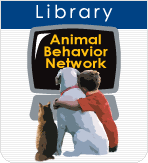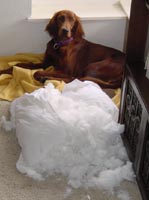|
Need Help? |
|
Call
1-800-372-3706
to
speak to a Veterinary Behavior Technician |
|
Paws for Help!
|
|

Click on Library Icon |
|
Help is at your
fingertips
by
library, email
and phone! |

Helpful Links
Close Tethering
Begging
 |
|
|
Dog
Preventive Behavior Counseling
Preventing Dog Bites
Preventing
Household Destruction
|
1)
|
Teach
a new dog "contented
confinement." Make
a portable kennel become
your dog's most favored
place. That kennel becomes
his overnight bedroom (and
softest available bed),
his dining room (pull the
bed and feed his meals inside)
and his recreation room,
where he gets to work on
getting the tasty treats
out of his food puzzle toy. |
|
2)
|
In
the corner of the area,
where you want the puppy
to sleep, place a comfortable
pet bed or towel on the
floor. Dogs normally spend
up to 80 percent of their
time sleeping anyway. |
|
3) |
Anytime
you are home and see him
showing interest in his
chew toys, praise. |
|
4)
|
Rotate
the toys so that they don't
become boring. Pack hollow
toys with food to encourage
their use. |
|
5) |
Do
not give items for chew
and play that very similar
to household items. The
pet may not be able to distinguish
them. |
|
6)
|
If
you find an inappropriately
chewed object, either prevent
access, or make the target
taste bad to the dog. A
home remedy is underarm
antiperspirant, and pet
stores sell many excellent
taste repellants. The use
of punishment by the owner
long after the destructive
act occurred is confusing
to the pet and damaging
to the relationship. |
|
7) |
If caught in the act, verbally
scold to stop
the behavior then lead
the dog over to the chew
toy (redirect) and happily
praise the acceptable chewing
outlet. No scolding should
continue after the instant
the teeth stop committing
the crime. |
|
8) |
New
pets should be supervised
even when the owners are
home to prevent misbehavior
from occurring out of their
view. |
| 9) |
Give
plenty of exercise and have
regular play sessions. Tired
dogs rarely destroy. |
Note:
If the destruction occurs only
when the dog's key person
is gone, attempt to determine
if separation anxiety is present,
and treat if diagnosed.
Preventing
Canine Housesoiling
Housesoiling is relatively easy
to prevent in either a puppy
or newly adopted dog without
any need for physical punishment.
|
1)
|
Teach the new dog "contented
confinement" as described
above under preventing
household destruction.
Confinement may be in the
portable kennel, tethered
near you, in a small room,
or restrained behind baby
gates. The goal is to tap
into the canine instinct
to not soil their resting
area. The most common error
is to give too much house
freedom too soon. Never
use crate for punishment. |
|
2)
|
Dogs
develop elimination location
preferences by 7 - 9 weeks
of age (the best time to
housetrain). Females may
need to eliminate more frequently
than males. |
|
3) |
A
rule of thumb for how many
HOURS a puppy can hold their
urine is their age in months:
+ 1. For example, a 3 month
old puppy can hold it 4
hours, a 5 month old puppy
can hold it up to 6 hours.
These are just estimates,
and vary with the individual. |
|
4)
|
Take
young dogs outside after
waking, shortly after eating,
and every few hours throughout
the day. |
|
5) |
Take
the dog out to a specified
(easy to clean) yard toilet
area. Keep him on leash
to prevent soiling the entire
yard. As the dog starts
to eliminate, give a Instruction
such as "Go Potty."
Allow 1-2 minutes, and don't
stare at the dog. Take the
dog out every few hours,
until an elimination pattern
is identified. |
|
6)
|
Take
dog to the same location
each time. Residual urine
and feces will encourage
further use of the area.
|
|
7) |
When the dog is done depositing
urine and feces, give a
"jackpot" reward
including playtime, leash
walk, treats and praise.
Accompany The dog outside
during housetraining every
time. Reward immediately
after elimination, not after
return to the house. |
|
8) |
If
very active during play,
return to the toilet area
before going inside the
house. |
| 9) |
Give
supervised freedom after
correct elimination, then
return to confinement and
a fresh chew toy. |
| 10) |
If no toilet deposit is
made, give no reward, and
return to confinement. Give
toilet access again later. |
| 11) |
Gradually
increase the indoor freedom
as a reward for correct
elimination, and use "accidents"
to determine the safe duration
of liberty indoors |
| 12) |
Difficult
to house-train dogs should
be screened for medical
problems. |
Preventing
Canine Aggression to Members
Of The Family
|
1)
|
Enroll any age dog in a
reward based group class.
This establishes a vocabulary
between you and the dog,
and introduces the ideal
relationship of owner/dog
as teacher/learner. |
|
2)
|
Establish
a routine of vigorous exercise
for life. This is a stress
release valve for all involved. |
|
3) |
Avoid physical punishment
altogether. Instead teach
the "Correction Protocol"
for dealing with any unwanted
behavior. This means a)
prevent it if possible,
b) if caught in the act,
interrupt the behavior,
c) redirect the dog into
an acceptable behavior,
then d) reward the "corrected"
behavior. E.g. if play nipping
is the problem, interrupt
it in the act by sudden
loud yelping and crying
(like a hurt playmate) as
if the pressure was excruciating
(= interruption). Then redirect
the puppy to playing with
its toys by tossing a ball
or squeaking a toy (= redirection)
Praise interest in the toy
and future gentle mouth
pressure on skin. |
|
4)
|
Teach
the dog to signal "Please."
Have a family agreement
that every time the dog
wants something, he must
signal "Please"
by sitting on Instruction; or
"Super Please"
by laying down on Instruction.
This way any family member
can indulge the dog, as
long as the dog signals
"Please" first.
This positions every family
member as a positive leader
by controlling the dog's
valued resources. |
|
5) |
Give
a gentle loving body massage
to your dog every day. This
desensitization to body
handling builds trust that
hands are friendly, and
helps establish a positive,
trustworthy relationship.
This is also an excellent
way to find health problems
early, and a reminder to
keep the dog well groomed
and pleasant to touch. |
|
Aggression is
preventable in most dogs,
although there is a small
percentage of the canine
population that will still
turn aggressive in some
context, even if an owner
does everything right. |
Preventing
Food-Related Aggression Toward
People
|
1)
|
From puppyhood teach the
dog the "Leave It,
Take It" game. One
way to begin this game,
is at feeding time. Have
a leash on the dog, and
put the food bowl down empty. |
|
2)
|
Hand
place a single piece of
special food in the bowl
and say "Leave it!"
Use the leash if needed
to gently pull the puppy
away from the food. |
|
3) |
As soon as the puppy gives
up attempting to get the
food, say "Take it"
and encourage the puppy
to eat the food. |
|
4)
|
Repeat
a few times with the food
in the bowl, or on the floor,
or lawn. Make sure he can't
get the food until you say
the words, "Take it." |
|
5) |
After the short training
session, give a bowl of
dry food, but massage the
dog while he's eating.
Periodically move your hand
near the dish, to drop a
tasty treat into the dry
food. The goal is to teach
the dog that a human coming
near your food dish is a
wonderful idea. |
| 6)
|
Avoid
feeding dog from table,
and pick up the dog's
food in-between meals. |
Preventing
Possessive Aggression Toward
People
Possessive aggression is defined
as aggressively defending non-food
items, like toys.
|
1)
|
Never challenge or use aggressive
means to respond to this
challenge. Take it as an
indicator that there is
a "control"
confusion, and it is time
to invest some time in behavior
modification. |
|
2)
|
In
a relaxed atmosphere, teach
the dog the "Drop
it" Instruction. Start
with some food treats and
two toys of low but similar
value to the dog, like two
balls. |
|
3) |
Hide one ball. Act playful
and try to get the dog to
take the other ball into
its mouth. |
|
4)
|
Then
say "Drop it"
and show the dog the other
ball. An unwritten rule
in dogdom is that whatever
you have is more valuable
that what they have. Therefore,
they will likely drop their
ball to try to get your
ball. |
|
5) |
Give "instructive
praise" like "Good
Drop it!" then give
or throw the second ball.
If the dog won't give
up the first ball, "trade
up" to something even
more valuable, like a food
treat. |
| 6)
|
Once
the dog will "Drop
it" on Instruction, work
up to more desirable toys,
like food related chews. |
| 7) |
Remove
objects that the dog repeatedly
guards aggressively. |
Preventing
Dog-Dog Aggression
Because of genetics and lack
of socialization, many adult
dogs respond negatively toward
other dogs. Depending on the
individual, this might be a
fearful, or aggressive reaction.
Inter-dog aggression is difficult
to correct, but easy to prevent.
|
1)
|
The canine brain develops
through specific stages.
The available dog-dog socialization
period is approximately
4 weeks of age to puberty.
Positive experiences with
other dogs early in this
period is very helpful to
prevent dog-dog aggression. |
|
2)
|
Find
a local puppy socialization
class. The ideal location
is inside the veterinary
hospital because the dog
then associates that location
with play and treats. Be
certain the class includes
off-leash play sessions
that are supervised to prevent
bad experiences. |
|
3) |
Fear prone puppies need
time to hide and gradually
build their confidence to
enter play. They must not
be accosted by a rambunctious
bigger puppy, even if the
bigger puppy means well. |
|
4)
|
Puppies
who tend to
control other
puppies need to be interrupted,
given time outs or redirected
to play with other larger
puppies. If feasible, use
2 separate play areas for
big vs. little puppies.
During time outs, more
controlling
personality puppies should
be required to sit or lay
down to engage in deference
postures and lower arousal. |
|
5) |
It is helpful to have an
adult "mentor dog"
in the play group, so that
the more
pushy puppies
are safely "put in
their place" if not
showing proper respect.
Each dog needs to learn
canine social manners, and
to prevent dog-dog aggression,
those manners are best learned
at an early age from another
dog. |
| 6)
|
Provide
a play group for your puppy
at least monthly during
the first 1-2 years of life.
Stopping socialization too
early can cause recurrence
of dog-dog aggression. Seek
dog parks or canine daycare
programs. For most dogs,
the opportunity to play
with other dogs is one of
the great delights of canine
life. |
|
|
|